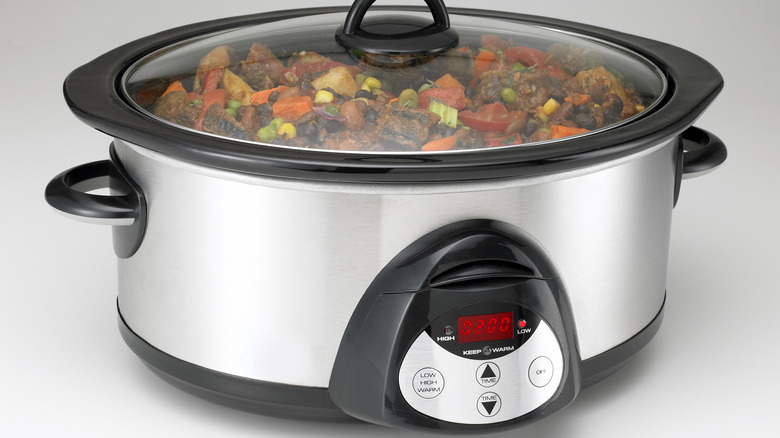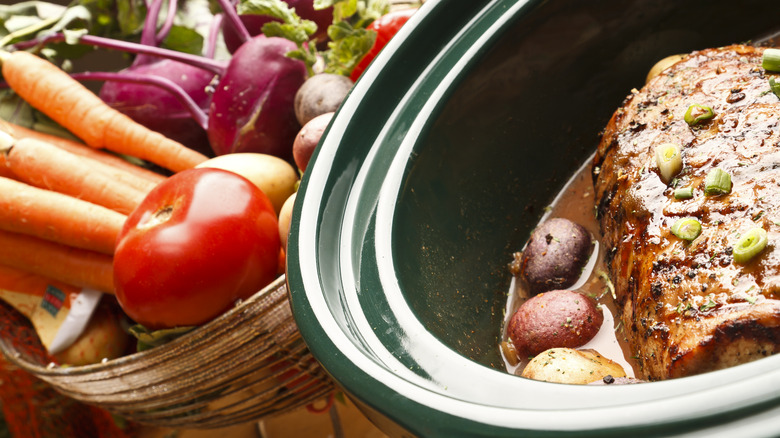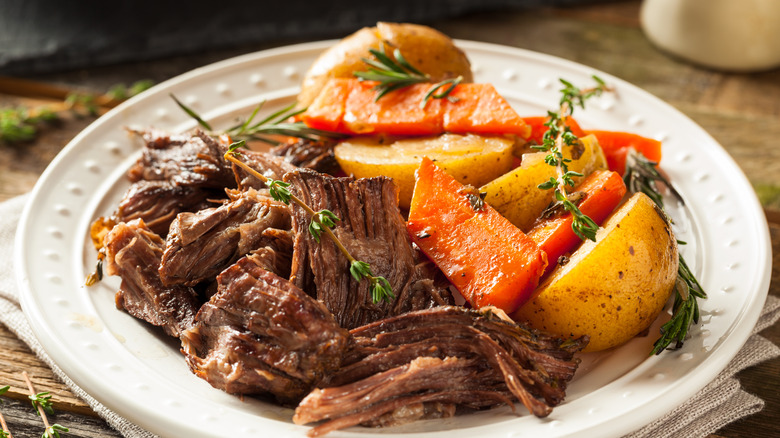The Warning Sign A Slow Cooker Recipe Isn't Worth Following
On a busy weeknight, especially during winter when we crave slow-cooked comfort foods, there's nothing more appreciated than coming home to a cooked meal, especially if you're pleasantly reminded of it by the delicious aromas as you walk into the house. Oh, joy! Countertop appliances like Instant Pots and Crock-Pots, which safely cook your meal while you go about your day, are indispensable time-savers for preparing stews, soups, fluffy bread rolls, and casseroles. Unfortunately, not every slow cooker recipe is worth the time and effort.
Slow cookers come in different capacities, ranging from a mini, which holds one quart of food, to an extra-large, which can hold seven to 10 quarts, ideal for a large family or entertaining. The size you need depends on what you plan to cook in it and how many people you are feeding. If a recipe doesn't specify the size and shape of the slow cooker required, it's a red flag that the meal may not turn out as expected.
Slow cookers should be filled halfway to three-quarters full for proper heat distribution, and to accurately estimate cooking time. Manufacturers often supply a cookbook or provide recipe links online, which are excellent resources for measurement guidelines. While most recipes can be adapted to your appliance size with some trial and error, if you don't want to babysit your meal for seven hours, consider finding a new recipe written specifically for your size and brand of slow cooker.
Why does size matter?
Unless your slow cooker is exclusively used for making soups, the amount of liquid in a recipe significantly affects how well the dish turns out. These appliances cook meals at a low temperature, which limits evaporation. Veggies with high water content, such as onions and tomatoes, add to the cooking liquid as they break down, often resulting in a dish that's more liquid than when you started. Because liquids don't reduce and flavors don't concentrate as they cook, the same beef stew recipe requires less liquid when prepared in a slow cooker.
Without necessary adjustments, a braising recipe intended for a larger slow cooker or to be cooked on a stovetop in a Dutch oven will end up diluted and soupy. Conversely, a recipe will cook quicker than expected if placed in a slow cooker that is too large, resulting in an overcooked meal. Size indeed matters.
The shape of the slow cooker's crock or bowl is also a factor. Slow cookers are available in circular, oval, and rectangular shapes in each size capacity. It's a mistake to assume a five-quart round slow cooker will cook the same as an elongated one with the same capacity, as more of the crock's surface area is in contact with the electric heating elements. Recipes for eggs and cakes designed to bake in narrow, tall slow cookers will cook too quickly and maybe even burn if made in a broader appliance.
Tips to successfully convert recipes for slow cookers
This doesn't mean you can only use recipes specifically designed for slow cookers. A few adjustments can successfully convert your favorite recipes for slow cooker use. When experimenting for the first time, choose a day when you can check on the dish a few times to make necessary adjustments. Until you get the proper measurements down, avoid leaving the ingredients in the pot for an eight-hour workday.
Slow cooker recipes generally require ½ to ¾ less liquid than a conventional recipe. Start with one-quarter of the liquid amount listed in the original recipe, and add more as necessary. It's easier to add than to remove. Roasts cooked with vegetables may require no additional liquid.
Since liquids don't reduce in slow cookers, avoid adding wine or beer, as the alcohol can't burn off as well, leaving an acrid taste in the dish. Substitute alcoholic beverages with a flavorful stock or broth, or reduce them separately in another pot on the stove.
When seasoning the dish, remember that spicy ingredients like horseradish and chili peppers intensify over time. Unless you prefer your dishes very spicy, hold off on adding chilis until the end of the cooking process. Similarly, fresh, delicate herbs like cilantro, parsley, and basil can't withstand seven hours of cooking, so garnish the dish with them before serving.



